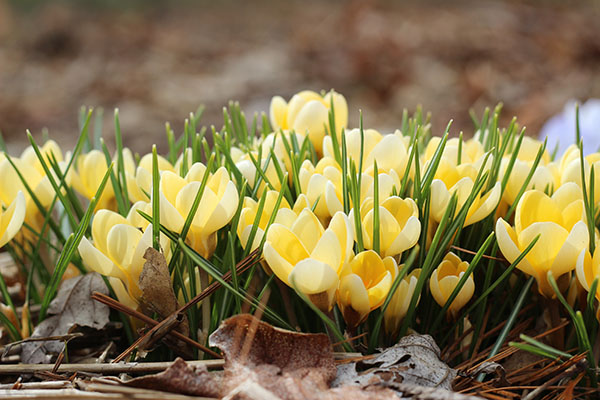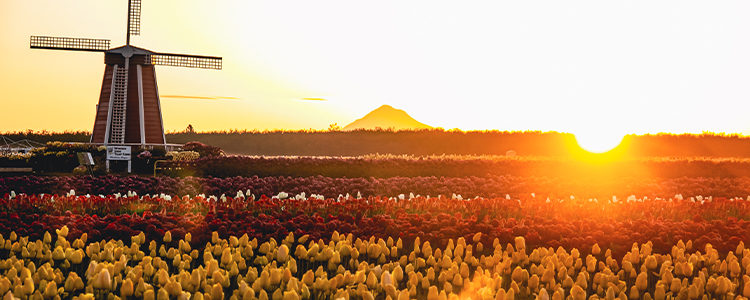To read more by topic or date, see our Newsletter Archives page.
April 2, 2023
“When well-apparell’d April on the heel
Of limping winter treads…”
Spring Shipping Begins Next Week

|
April isn’t quite here, but our weather is becoming more spring-like (though nights are still below freezing the next few days) and we’re planning to start shipping spring orders that don’t include iris next week. We’ll be shipping to customers in zone 8 and above, since it’s already well into spring for them, then continue with the earliest orders (placed back in September) and move forward from there. We need to wait for the iris to start growing before we can ship those orders, but we’re hoping to start with them the second week of April. We’ll send you an email with tracking information when your box leaves here so that you’ll know when to start looking for it. We plan to have current orders shipped by the end of April (unless you asked for them to come in the first week of May.)
Each variety will be labeled with concise planting directions and the Heirloom How-To included with each order is full of specific planting and care information that should set you up for great success. Please open your box right away! Check to see if you need to plant anything right away or whether you should wait for warmer weather.
It’s Not Too Late to Order – and Save 10-25% on Select Varieties!
Can’t decide? Try our 7 easy samplers including the ever-popular Intro to Heirlooms – $35 worth of summer beauty (or more!) for just $30.
Or start at our Bulbs on Sale page for 27 spring-planted treasures at savings of 10-25%, including ‘the lovely ‘Preference’ dahlia’, fragrant Abyssinian gladiolus, sunny ‘George Davison’ crocosmia, and the ‘Gertrude Condon’ daylily.
Or check out all of our perennial lilies, freshly-dug iris, many different dahlias, unusual glads, fragrant tuberoses, pixie rain lilies, and easy-to-grow daylilies.
Don’t miss out on all the fun. Order your own box-load of summer excitement now – before everything is gone! (If you’d like to add to an earlier order, please do so by noon Tuesday April 3; once shipping begins, it’s problematic to make changes to an existing order.)
First-time Daffodils Coming for October!
Vanessa’s research has located nine heirloom daffodils which we’re delighted to be able to add to our fall offerings this year. Unlike the prototypical image we often have of a daffodil having a single flower made up of a cup, large or small, surrounded by a perianth of six petals, many of these are either doubles (one or more flowers to a stem, with doubling of the perianth segment, the cup, or both) or Papillon daffodils (having a split cup which often is open and relatively flush with the perianth, like a butterfly’s open wings at the center of the flower). Please welcome:
• Luminous yellow with bright orange ‘Double Fashion’ (1965)
• Free-flowering and frothy double ‘Flower Drift’ (1966)
• Cheery, sweetly-fragrant jonquil ‘Kinglet’ (1959)
• Stunning Papillon ‘Orangery’ (1957)
• Primrose and ivory ‘Papillon Blanc’ (1960)
• Stylish, frilly split-cup ‘Parisienne’ (1961)
• Bright yellow with bicolor cup ‘Pinza’ (1962)
• Irish white and yellow double ‘Westward’ (1962)
• Multi-flowered, frilly ‘White Marvel’ (1950)
Celebrate Spring at a Tulip Festival or American Daffodil Society Display Garden

|
Our friends at the ADS just held their annual meeting in Atlanta, highlighted by not only the daffodils entered in the competition but by tours offered to nearby Approved Display Gardens of which there are currently 28 in fifteen states across the country. Both public and private, they are chosen for having a wide variety of daffodil cultivars as well as showing gardeners how to use them effectively in the landscape. To find one in a state near you, and for links to the gardens for virtual visits, see their website (ADS Approved Display Gardens ) There’s nothing quite like seeing thousands of daffodils in bloom, and some of the gardens (like Filoli in California, the Robbins-Hunter Museum in Ohio, and Winterthur Museum in Delaware) have fascinating histories and period buildings to visit as well.
Tulip festivals will be starting as spring comes north, including Washington’s Skagit Valley Tulip Festival and Oregon’s Wooden Shoe Tulip Festival in April, Iowa’s Tulip Time and Michigan’s Tulip Time (the largest tulip festival!) in early May, and New York’s 2023 Albany Tulip Festival May 13-14. To see how the City of Holland (Michigan) plants bulbs for the festival using a custom-designed machine, check out Planting Tulips on Windmill Island.
Rita’s Easy Way to Get Your Dahlias Eyed Up and Sprouting
You don’t have to start your dahlias indoors, but it can be fun – and reassuring if you’re new to dahlias. Here’s how our long-time office manager Rita Bailey does it.
First of all, if you don’t see any eyes on your tubers when they arrive, don’t worry. This is perfectly normal. And if you do see eyes, just store it in a cool, dark place, or start it in a pot under lights.
If you have over a month, you can try potting them up (see below). But if you’ll be planting sooner, use peat or coir and a plastic bag with a few holes punched in it for ventilation. Put some peat/coir that’s moist but not soggy in the bag, lay your tuber on it, and close the bag. Set it someplace warm (room temperature is fine) and bright (but not in direct sun), and keep an eye on it - if you see moisture condensing on the bag, open it part way or punch another hole. Too much moisture will cause your tuber to rot.
If you won’t be planting for a while, it’s fine to store your tubers as above, or for a head start.
1. Begin a month or even six weeks before your area’s last frost date. Find yours by zip code at almanac.com/gardening/frostdates.
2. For each tuber you’ll need some potting soil and a nursery pot or clear plastic deli container. Any size is okay as long as the tuber fits, Rita says, since it won’t spend much time in either.
3. Within a week or two you’ll see eyes – little purplish or pale bumps like the eyes of a potato – emerging from the crown just below the old stem. Poke a drainage hole in the bottom of the deli container, fill it with damp potting soil, set it on a saucer (or in a shorter deli container, as in the photo), and plant your eyed-up tuber with the crown covered by about an inch of soil.
4. Keep it warm. Within a week or so, small white roots will begin to show at the sides of the container. Enjoy that sign of progress as you wait for the first sprout to emerge above the soil which, according to Rita, sometimes takes as long as two more weeks depending on the variety (Wisconsin Red and Thomas Edison are notoriously late!).
5. Once you see a sprout, give it as much light as possible and gently shake the container once or twice a day to help strengthen the new growth. If the container starts to fill with roots, you can gently transplant it to a pot.
6. As your last-frost date approaches, get your dahlia acclimated to outdoor conditions by hardening it off. This means setting it outside for a short period of time every day. Start with an hour or so in a sheltered spot and gradually increase the time and exposure until your plant is tough enough to spend all day in full sun.
7. When it’s hardened off and the last-frost date is past, gently remove it from its container and plant it outside, burying the tuber a little deeper than it was in the container. Water it well and enjoy!
Share Our Gazette with a Friend
Please help us “Save the Bulbs!” by forwarding our newsletter to a kindred spirit, garden, museum, or group.
To Reprint Any Part of Our Gazette . . .
Simply credit www.oldhousegardens.com.











